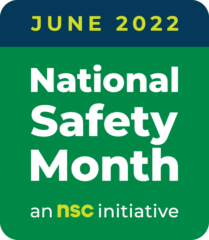
June is National Safety Month, an annual observance to help keep each other safe from the workplace to anyplace. For more than 25 years, the National Safety Council (NSC) has provided resources to highlight leading causes of preventable injury and death so people can live their fullest lives.
The NSC offers free weekly resources to help keep workplaces safe. This year’s topics: Week One: musculoskeletal disorders (MSDs): Week Two: workplace impairment, Week Three: injury prevention and Week Four: slips, trips and falls.
Safety in the workplace covers a wide array of topics and areas. We will highlight a few area for safety in the health care environment.
- Emergency Preparedness: Natural and man-made disasters can strike at any time. It’s important to have a
 planned response when you’re at work, on vacation or on the road.
planned response when you’re at work, on vacation or on the road. - Opioids at Work: Begin to address opioid use in your organization. This free toolkit includes sample policies, fact sheets, presentations, 5-minute safety talks, posters, white papers, reports, videos and more so you can implement a workplace program on opioids.
- Fatigue at Work: Nearly 13% of workplace injuries may be attributed to fatigue, and more than 40% of U.S. workers are sleep deprived. Fatigue is having an impact on your workforce and your bottom line.
- COVID-19 and the Workplace. In May 2021, the National Safety Council updated its SAFER Framework with the latest guidelines, including ventilation and filtration guidance, long-term implications of remote work and flexible schedules and vaccine policies.
Every organization could benefit and can participate in National Safety Month. Ideas for workplace activities include:
- Companies can conduct a safety meeting or toolbox talk on the weekly focus and encourage a discussion among team members.
- Organizations can send out weekly emails with the related articles and tip sheets to allow employees to read as they have time throughout the week.
- Articles and tip sheets can be printed out and provided to team members or posted on bulletin boards in common areas.
- Leadership can email a personal letter to all employees about what National Safety Month means for them with the message they want to convey to all employees.
- Supervisors and managers can lead team safety activities such as conducting safety equipment inspections, developing rescue plans, or discussing job specific hazards.
- Organizational leadership can recognize individuals or teams for positive safety-related accomplishments.
The National Safety Council, America’s leading nonprofit safety advocate for more than 100 years, focuses on areas it can make the greatest impact. NSC safety training is trusted worldwide. Armed with the latest research, NSC experts start by incorporating OSHA compliance regulations into the courses they design. But NSC courses go way beyond these basics to include global best practices to prevent injuries and death. NSC starts in the workplace, giving companies resources workers can actually use around risks they are actually facing. NSC helps employers create a culture of safety that will make people safer — from the workplace to anyplace. Lean more.
Additional Resources:
